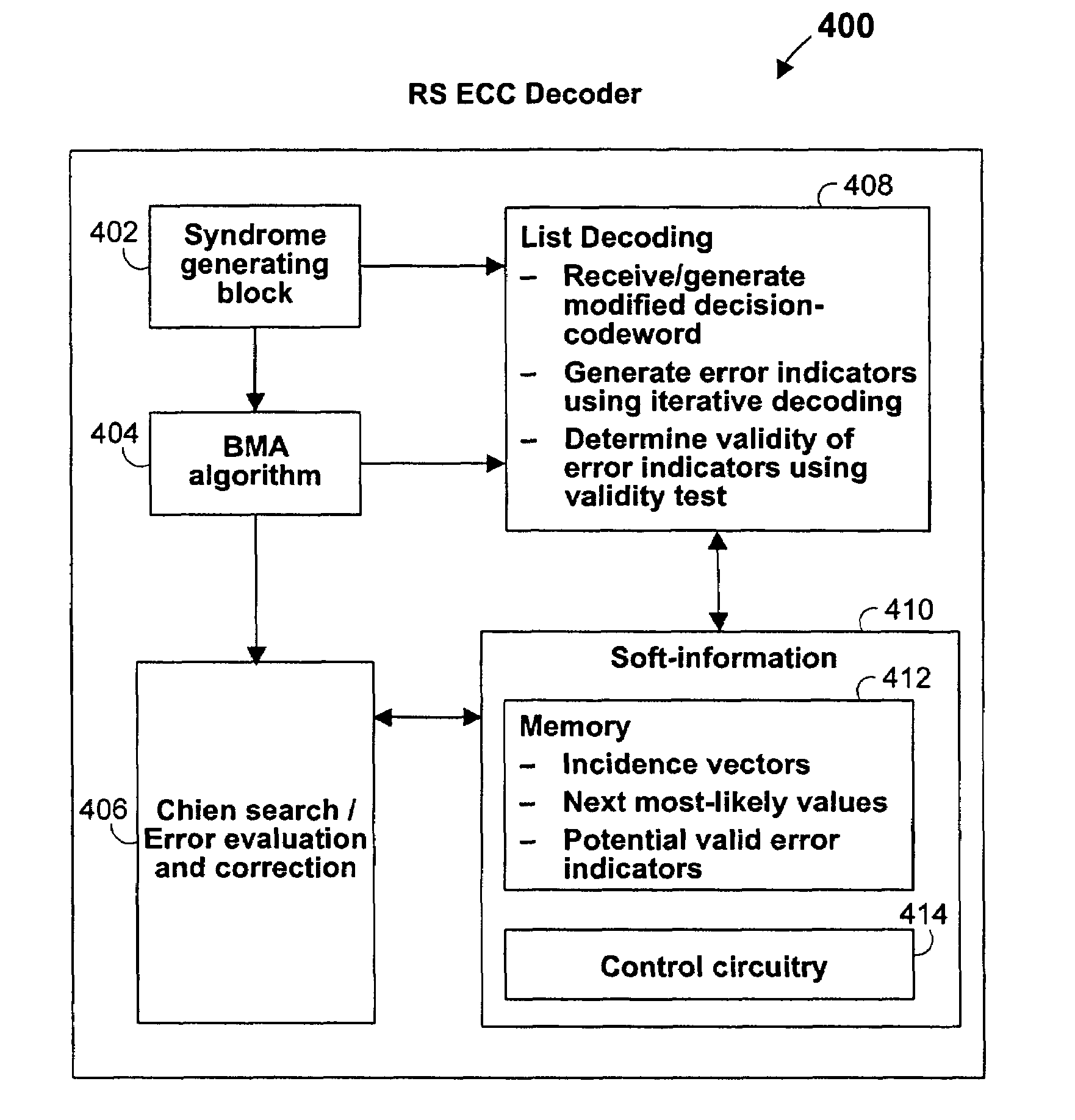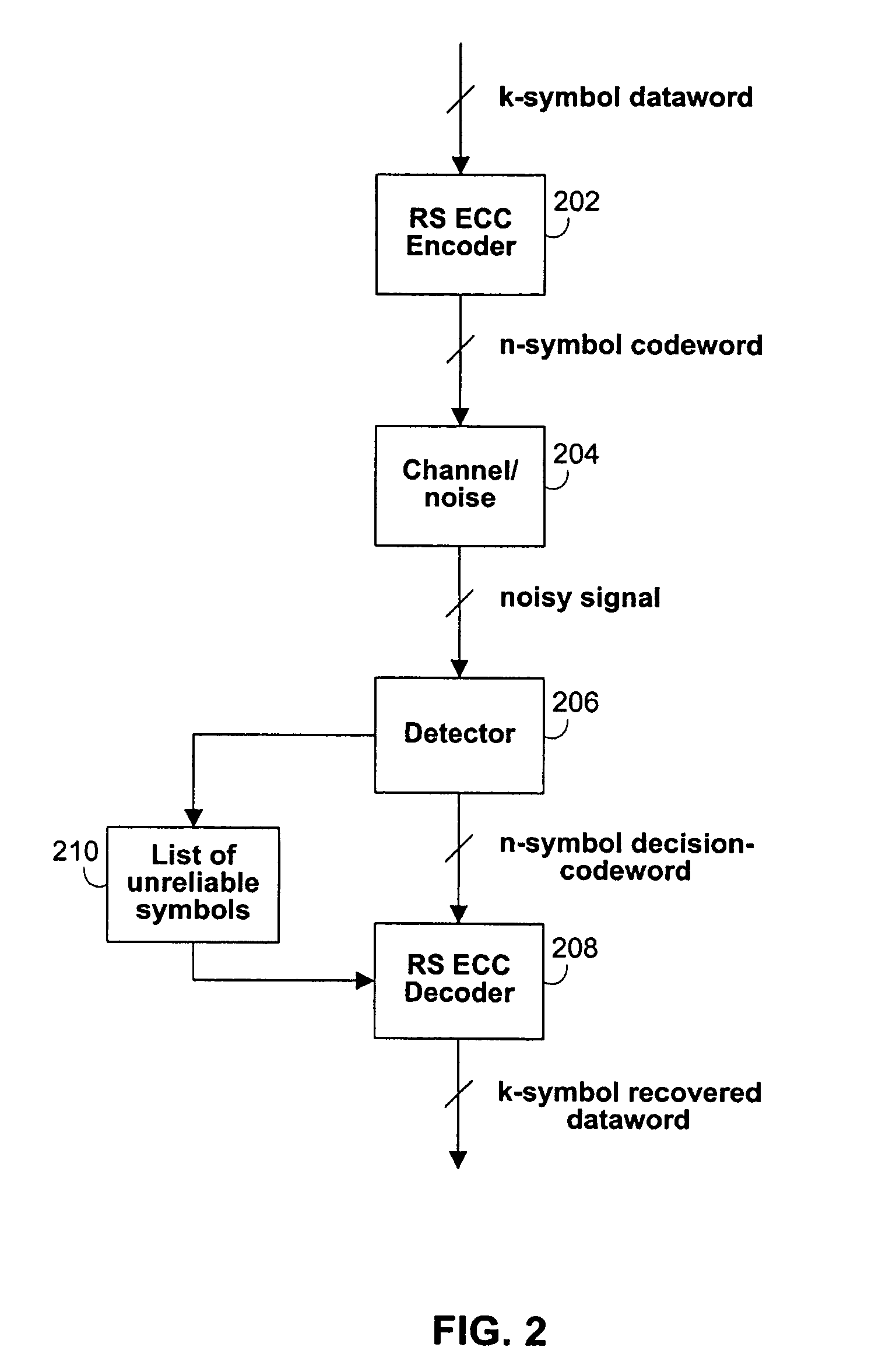Architecture and control of reed-solomon list decoding
a technology of reed-solomon and list decoding, applied in the field of reed-solomon errorcorrection codes, can solve the problems of limited practical considerations, inability to adapt to certain applications of reed-solomon ecc, and relatively complex rs ecc encoding and decoding techniques, etc., to achieve the effect of reducing the amount of memory needed
- Summary
- Abstract
- Description
- Claims
- Application Information
AI Technical Summary
Benefits of technology
Problems solved by technology
Method used
Image
Examples
case 1
[0056] deg(Λ(x))
Λ(e1)(x)=Λ(x)+axΛ(x)+bxB(x) (EQ1)
B(e1)(x)=Λ(x)+cB(x) (EQ2)
case 2
[0057] deg(Λ(x))>deg(B(x))+2
Λ(e1)(x)=Λ(x)+axB(x)+bx2B(x) (EQ3)
B(e1)(x)=xB(x)+cB(x) (EQ4)
where the variables and their computations are described by the Burd reference.
[0058]The computations for equations EQ3 and EQ4 in case two are not shown in the Burd reference because the Burd reference recognizes that case two can be handled in a manner similar to case one. For the sake of completeness, one embodiment for computing equations EQ3 and EQ4 in case two will now be described. Starting with syndromes S(x), an error locator polynomial Λ(x), and a scratch polynomial B(x) for a decision-codeword, a modified syndrome polynomial Si(e1)(x), quotient polynomials QΛ(x), QxΛ(x), QB(x), QxB(x), Qx2B(x), and remainder values rΛ, rxΛ, rB, rxB, rx2B can be computed in the same way as case one. Based on these values, intermediate variables d1, d3, and d4 can be computed by:
[0059]d1=∑i=0S2t-1-i(e1)(QΛ)id3=∑i=0S2t-1-i(e1)(QxB)id4=∑i=0S2t-1-i(e1)(Qx2B)i.(EQ5)
The upper bound of the summ...
case1
[0063]Case1:deg(Λ(x))<deg(B(x))+2Λ^(el)(x)=Λ(el)(x)x+α-jl=Λ(x)+axΛ(x)+bxB(x)x+α-jl=QΛ(x)+axQΛ(x)+bxQB(x)(EQ8)Case2:deg(Λ(x))≥deg(B(x))+2Λ^(el)(x)=Λ(el)(x)x+α-jl=Λ(x)+axB(x)+bx2B(x)x+α-jl=QΛ(x)+axQB(x)+bx2QB(x)(EQ9)
[0064]For a new error locator polynomial, the Burd reference describes a way to predict the validity of the error locator polynomial by using a “validity test.” Specifically, when there is one extra syndrome, the validity test is:
[0065]∑i=0S2t-iΛi(el)=0,(EQ10)
and when there are A extra syndromes, the validity test is:
[0066]∑i=0S2t-1+j-iΛi(el)=0,j=1,…,Δ.(EQ11)
One of equations EQ10 and EQ11 is used depending on the number of extra syndromes. When the equality or equalities are determined to be true, the new error locator polynomial can be presumed to be valid and can be passed to a Chien search module where it's validity can be verified. Alternatively, the validity test of equations EQ10 and EQ11 can be modified to use th...
PUM
 Login to View More
Login to View More Abstract
Description
Claims
Application Information
 Login to View More
Login to View More - R&D
- Intellectual Property
- Life Sciences
- Materials
- Tech Scout
- Unparalleled Data Quality
- Higher Quality Content
- 60% Fewer Hallucinations
Browse by: Latest US Patents, China's latest patents, Technical Efficacy Thesaurus, Application Domain, Technology Topic, Popular Technical Reports.
© 2025 PatSnap. All rights reserved.Legal|Privacy policy|Modern Slavery Act Transparency Statement|Sitemap|About US| Contact US: help@patsnap.com



